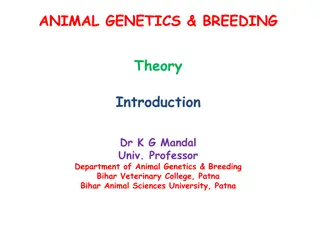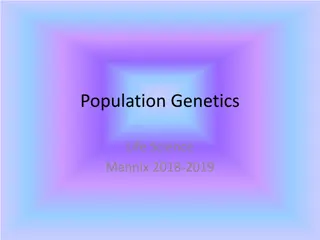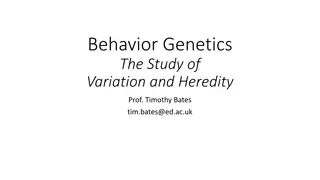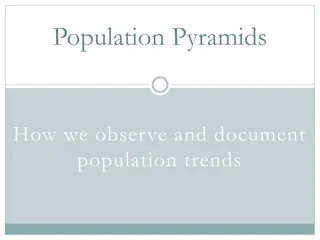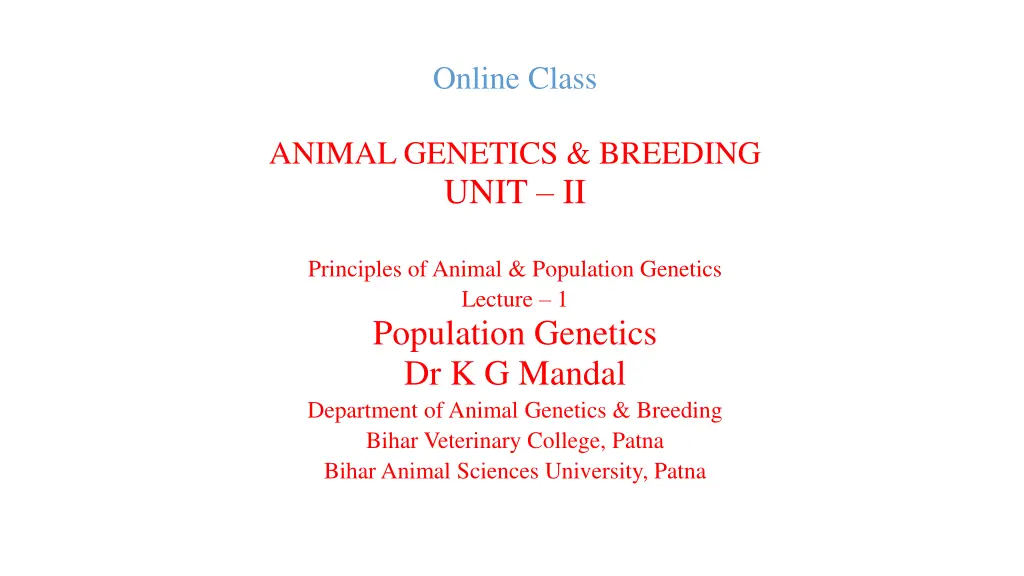
Animal Genetics & Breeding: Population Genetics Overview
Explore the fundamental concepts of population genetics in animal breeding, including genetic structure, gene frequencies, and genotype frequencies at the population level. Learn about the traits studied, such as qualitative and quantitative traits, and their analysis methods. Discover the characteristics of populations and the objectives of population genetics studies.
Download Presentation

Please find below an Image/Link to download the presentation.
The content on the website is provided AS IS for your information and personal use only. It may not be sold, licensed, or shared on other websites without obtaining consent from the author. If you encounter any issues during the download, it is possible that the publisher has removed the file from their server.
You are allowed to download the files provided on this website for personal or commercial use, subject to the condition that they are used lawfully. All files are the property of their respective owners.
The content on the website is provided AS IS for your information and personal use only. It may not be sold, licensed, or shared on other websites without obtaining consent from the author.
E N D
Presentation Transcript
Online Class ANIMAL GENETICS & BREEDING UNIT II Principles of Animal & Population Genetics Lecture 1 Population Genetics Dr K G Mandal Department of Animal Genetics & Breeding Bihar Veterinary College, Patna Bihar Animal Sciences University, Patna
Population Genetics What is Genetics? Branch of Genetics 1. Mendedion Genetics 2. Cytogenetics 3. Biochemical Genetics 4. Molecular Genetics 5. Quantitative Genetics 6. Biometrical Genetics 7. Population Genetics
Introduction to Population Genetics Study of genetics at population level is known as population genetics. Population is the unit of study. Study of genetic structure of a population is known as population genetics. Gene frequencies & genotype frequencies of a population for a given locus constitute the genetic structure of a population. Hence, the study of gene frequencies and genotype frequencies of a population in respect to a given locus is also known as population genetics.
What is a Population? Population in general Statistically Biologically Genetically Limits, size and nature of a population Limit of a population Size of a Population Nature of a Population Types of Population Subordinate Mendelian Population Closed Population or Isolates Idealized Population Real Population
Objectives of the study of Population Genetics It is trait specific 1. Qualitative traits 2. Quantitative traits Qualitative traits: To know the frequency of genes and genotypes at a given locus. To determine the change of gene and genotype frequencies from generation to generation under the influences of certain forces. Quantitative traits: To know the effect (magnitudes) of polygenes and their potentiality changing the mean (average), correlation, regression, heritability, repeatability and response to selection.
Qualitative traits Vs Quantitative Traits SI. No. 1 Particulars Qualitative Traits Quantitative Traits Measured/quantified thorough metric units kg, g, mt, cm, ml, lit, lbs etc. Measurement of Characters Countable 2 No. of genes involved One, two or a few Many more polygenes polygenic traits Minor 3 4 5 Effect of gene Variation Causes of variation Major Discrete (Discontinuous) Continuous Genetic Genetic & environment both 6 Methods of analysis X2(Chi-square) Mean, SE, SD, CV%, variance, correlation, regression, ANOVA etc.
Genetic structure of a population Gene frequency: Proportion or percentage of different alleles present at each locus in a population is known as gene frequency. Frequencies of all the alleles together at a given locus is equal to one or 100% percent. Genotype frequency: Proportion or percentage of individuals that belong to each genotype in respect to a locus is known as genotype frequency. Sum of the frequencies of all the genotypes for a given locus is equal to one or 100%.
Relationship between gene frequencies and genotype frequencies _________________________________________________________ Genes A1 A2 Frequencies p q __________________________________________________________ p + q = 1 & Genotype A1A1 A1A2 A2A2 P H Q P + H + Q = 1 Hence, Frequency of A1(p) = P + 1/2 H Frequency of A2(q) = Q + 1/2 H
Hardy-Weinberg Law (1908) In a large random mating population the gene frequencies and genotype frequencies tends to remain constant from generation to generation in absence of migration, mutation and selection, and genotype frequencies of the progeny is determined by the gene frequencies of the parents not by the genotypes frequencies. Large Population? Random mating population? Mutation? Selection? Hardy- Weinberg equilibrium A population with constant gene frequencies and genotype frequencies is said to be in Hardy-Weinberg equilibrium. G. H. Hardy-An English mathematician, Wilhelm Weinberg :AGerman Physician
Conditions required for holding H-W Law 1. 2. 3. 4. 5. 6. Population should be large & random mating No selection at any stage Genes should segregate normally at gametogenesis. Equal gene frequencies in males & females No migration of genes Mutation is disregarded.
Proof of Hardy-Weinberg Law 1. By random union of gametes 2. By random mating of genotypes 1. By random union of gametes It involves 4 steps: i) From gene frequency in parents to gene frequency in gametes ii) From gene frequency in gametics to genotype frequencies in zygotes iii) From zygotes to adults iv) From genotype frequencies to gene frequencies in progeny.
Gametic types, their frequencies and product of gametic frequencies Female gametes & their frequencies. A1 p A1 A1 p2 A2 q Male gametes &their frequencies A1 p A2 q A1 A2 pq A1 A2 pq A2 A2 q2 Genotype of zygotes/ progeny and their frequency Genotypes A1 A1 A1 A2 A2 A2 Frequency p2 2pq q2
The gene frequency in the adult progeny can be found from the relationship between gene frequencies and genotype frequencies Thus, the frequency of A1 is = p2+1/2 (2pq) = p2+pq = p(p + q) = p since, p + q=1 Similarly, frequency of A2 is q2+1/2 (2pq) = q2+pq = q (q + p) = q since, q + p=1 Hence, gene frequency in the progeny generation is the same as in the parent generation. This is proved HW law
Properties of equilibrium population 1. The genotype frequencies are determined by the square of the sum of the gene frequencies. Frequency ofA1= p, A2 = q, then A1A1 A1A2 A2A2 (p + q)2 = p2 + 2pq + q2 (p + q + r)2 = p2 +q2 + r2 +2pq +2pr = 2qr 2. The relationship between gene frequencies and genotype frequencies are applied to a single generation only. 3. Genotype frequencies in the progeny depend only on the gene frequencies of the parent, not on the genotype frequencies. 4. Maximum frequency of heterozygotes will be 50% at p = q = 0.5. 5. Frequency of rare allele occurs almost exclusively in the heterozygotes condition. 6. Proportion of heterozygotes is twice the square root of the product of frequency of two homozygotes.
Application of Hardy-Weinberg law 1. To determine the frequency of recessive allele Frequency of recessive homozygotesA2A2=q2, hence.A2= q2 = q 2. To determine the frequency of carrier Frequency of carrier, H1= 2pq P2+ 2pq. 3. To test Hardy-Weinberg equilibrium. X2(chi-square) test is used to test it.








